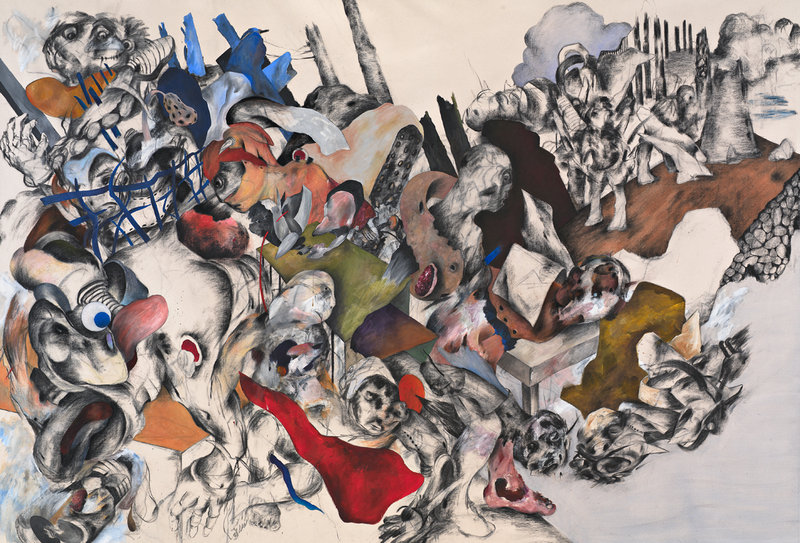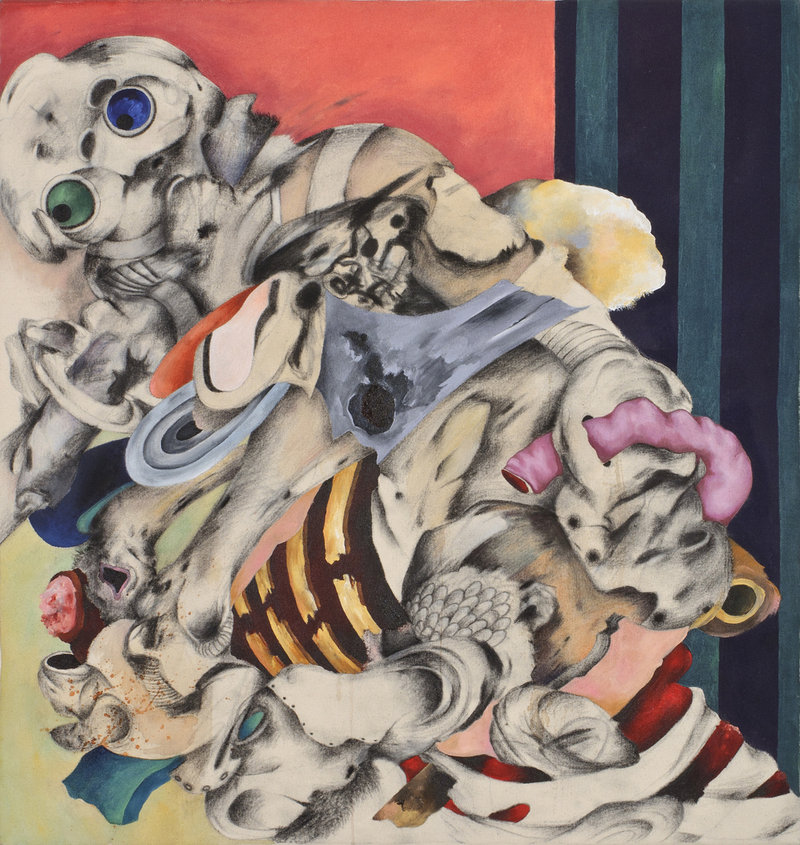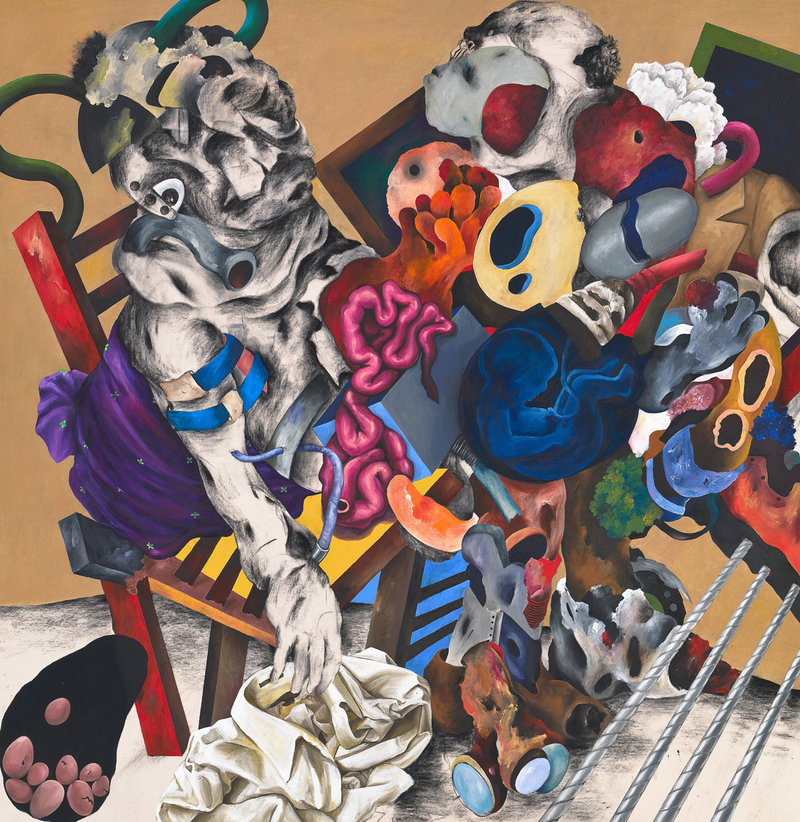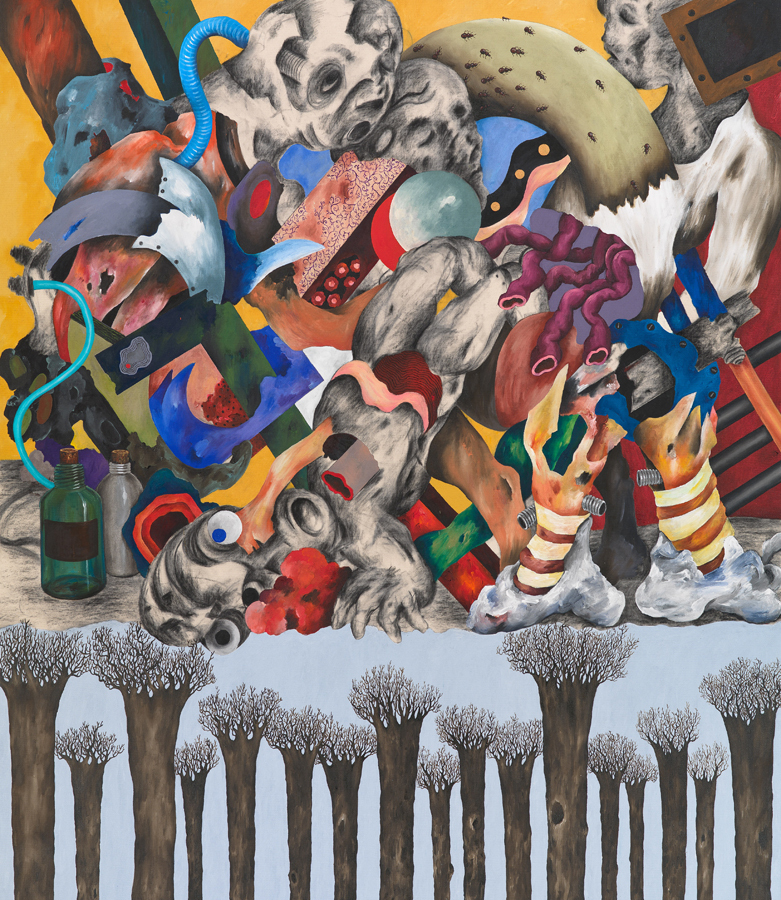For its latest exhibition, the Portland Museum of Art offers 20 paintings by internationally renowned artist Ahmed Alsoudani, an Iraqi-born, American-educated artist and Maine College of Art alumnus.
All are untitled, and collectively the 20 paintings and works on paper tell a story of human suffering and a world in chaos, torn by tumult and horror. They are colorful, grotesque, tragic, humorous. They are difficult, challenging, confounding, authentic.
“There is nothing harder than an artist trying to tackle contemporary politics and war,” said museum director Mark Bessire, who coordinated the show in conjunction with the Phoenix Art Museum. “It’s easy to fail. He’s brave to take on a subject matter that’s so hard and translate it into good art.”
“Ahmed Alsoudani: Redacted” features the work of an artist whose personal story is almost impossible to separate from the art that he creates. Alsoudani was born in 1975 in Baghdad, and left his home country for Syria as a teenager. He lived under the regime of Saddam Hussein, and began thinking politically at a young age.
Alsoudani left his country because he defaced a public image of Saddam and worried about consequences of his action. He came to the United States in the late 1990s, and found his way to Portland.
With a small portfolio of work in hand, he enrolled at Maine College of Art, from which he graduated in 2005. He studied at the Skowhegan School of Painting and Sculpture the following year, then enrolled for graduate work at the Yale School of Art, where he received his master’s degree in 2008.
Since then, Alsoudani’s career has reached an international scale. His large pieces now sell for hundreds of thousands of dollars, and his work is shown around the world. He was part of the Venice Biennale in 2011. He now lives and works in New York.
The Portland show, which is on view through Dec. 8, represents the artist’s first major museum exhibition.
“He is the perfect artist for us,” said Bessire. “He is internationally acclaimed. He has major representation, and we wanted to be the institution to present his first major museum show. He helps us redefine the Maine artist. Maine had an impact on him, and even though his work does not look like Homer or Marin, this place still had an impact on him.”
Alsoudani talks energetically about the influence of Maine on his discipline as an artist. He learned to paint here, was directly influenced by his teachers at MECA and Skowhegan, and maintains ties not only with both schools, but with the larger community of Maine art.
“It’s almost every artist’s dream to have a show in the museum,” he said. “There’s nothing unique about that. But the thing that makes it unique for me is that Portland is my home. It’s where I grew up as an artist. I have a different relationship with the city than any other place. I spent almost seven years of my life in Portland.”
As a student at MECA, Alsoudani walked to the museum to see exhibitions and study famous paintings. Now, he’s showing his work there. “It’s a great feeling,” he said, “and really quite incredible.”
Most of the 20 paintings in “Redacted” are new, created within the past two years. Alsoudani has moved from painting the horror and suffering of war to placing blame on world leaders who allow war to happen.
He noted that the timing of this show is particularly relevant, given the situation in Syria and the ongoing turmoil of the Arab Spring, when most of these paintings were made.
“I used to address certain issues in an almost direct way, when I talk about chaos and violence,” he said. “The last couple of years, it’s really more about corruption, chaos around the world and about politicians specifically. They are sources of the violence. The decisions they make lead to the violence and chaos. So I am going back to the chaos that I used to address in a direct way.”
In his work, Alsoundani draws influence from the likes of Francisco Goya, Pablo Picasso and George Grosz. Bessire also detects the influence of German expressionists in Alsoudani’s work, and notes that the artist lived in Berlin briefly before moving to New York.
Instead of glorifying violence, these paintings offer imagery that includes dismembered bodies, gas masks and ever-present, all-seeing eyes.
The images pop with color and a high degree of technical execution. Bessire is particularly impressed at how effectively Alsoudani handles both paint and charcoal side by side.
The artist also manages to infuse traditional Middle Eastern iconography in his work, though these paintings are thoroughly modern, Bessire said.
Staff Writer Bob Keyes can be reached at 791-6457 or:
bkeyes@pressherald.com
Twitter: pphbkeyes
Send questions/comments to the editors.







Success. Please wait for the page to reload. If the page does not reload within 5 seconds, please refresh the page.
Enter your email and password to access comments.
Hi, to comment on stories you must . This profile is in addition to your subscription and website login.
Already have a commenting profile? .
Invalid username/password.
Please check your email to confirm and complete your registration.
Only subscribers are eligible to post comments. Please subscribe or login first for digital access. Here’s why.
Use the form below to reset your password. When you've submitted your account email, we will send an email with a reset code.